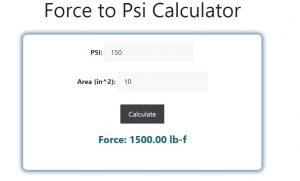About Force to Psi Calculator (Formula)
Understanding the relationship between force and pressure is essential in various fields, including engineering, physics, and hydraulics. The Force to Psi Calculator allows users to convert pressure measured in pounds per square inch (PSI) into the corresponding force applied over a specific area. This calculator simplifies the process, enabling quick and accurate calculations to help in project planning, design, and analysis. In this article, we will explore the formula, how to use the calculator, provide an example, and answer common questions related to this concept.
Formula
The formula for calculating force from PSI is:
F = PSI * A
In this formula, F represents the force exerted, PSI is the pressure in pounds per square inch, and A is the area over which the pressure is applied.
How to Use
Using the Force to Psi Calculator is straightforward:
- Determine the Pressure (PSI): Identify the pressure exerted in pounds per square inch.
- Determine the Area (A): Measure or calculate the area (in square inches) over which the pressure is applied.
- Apply the Formula: Input your values into the formula to calculate the force.
- Analyze the Results: The resulting force will indicate how much force is being exerted due to the specified pressure over the given area.
Example
Suppose a hydraulic system operates at a pressure of 150 PSI and the area of the piston is 10 square inches.
Using the formula:
F = PSI * A
F = 150 * 10 = 1500 pounds
In this example, the force exerted by the hydraulic system is 1500 pounds.

FAQs
- What does PSI stand for?
PSI stands for pounds per square inch, a unit of pressure. - How is force related to pressure?
Force is the product of pressure and the area over which that pressure acts. - What units are used for force in this calculation?
Force is measured in pounds (lbs) in this context. - How do I calculate the area if it’s not provided?
Area can be calculated using the formula A = length * width for rectangular surfaces or A = π * r² for circular surfaces. - Can I use this calculator for fluids and gases?
Yes, the formula applies to both fluids and gases, as long as the pressure is measured in PSI. - What is the significance of converting PSI to force?
Converting PSI to force helps in understanding the total force exerted in systems like hydraulics, pneumatics, and mechanical devices. - Is this formula applicable in all engineering fields?
Yes, it is widely used in mechanical, civil, and aerospace engineering to analyze forces in systems. - What if I have pressure in different units?
You will need to convert the pressure to PSI before using the calculator (e.g., from bar or kPa). - Can the Force to Psi Calculator help in designing hydraulic systems?
Yes, it is essential for ensuring that the components can withstand the forces generated at specific pressures. - What safety considerations should I take into account when using this formula?
Always consider the maximum pressure rating of materials and components to avoid failure or accidents. - How can I check my calculations for accuracy?
You can verify your results by cross-referencing with a manual calculation or using a different pressure conversion calculator. - Does the area need to be in square inches?
Yes, to maintain consistency with the PSI unit, the area should be in square inches. - What tools are available for measuring pressure in PSI?
Pressure gauges, manometers, and transducers are commonly used tools for measuring PSI. - How do temperature and fluid properties affect PSI?
Temperature can affect the pressure in a system, especially for gases; understanding the properties of the fluid is important for accurate calculations. - Can I use this formula for non-linear systems?
This formula is primarily for linear relationships; non-linear systems may require more complex calculations. - What types of applications commonly use PSI measurements?
Applications include hydraulic systems, pneumatic systems, automotive engineering, and HVAC systems. - Is there a maximum pressure limit for using this calculator?
No specific limit, but ensure the components involved can safely handle the calculated force. - What happens if the pressure changes?
Any change in pressure will directly affect the calculated force, so it’s essential to update calculations as needed. - How can I convert force back to PSI?
You can rearrange the formula to calculate PSI as PSI = F / A. - Are there any online tools for quick calculations?
Yes, many online calculators can perform these calculations for you with just a few inputs.
Conclusion
The Force to Psi Calculator is a valuable tool for anyone needing to convert pressure to force, whether in engineering, construction, or scientific research. By understanding how to apply the formula and interpreting the results, users can make informed decisions based on the forces acting in their systems. Regularly using this calculator can enhance accuracy in design and analysis, ultimately contributing to the success of various projects.
